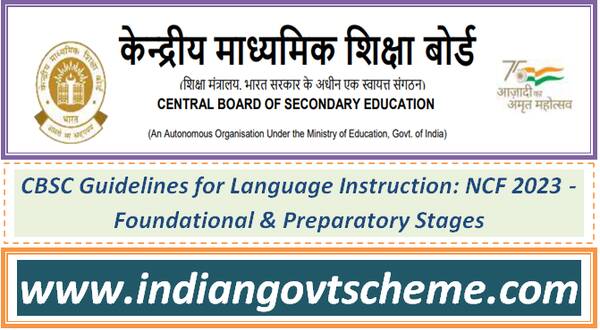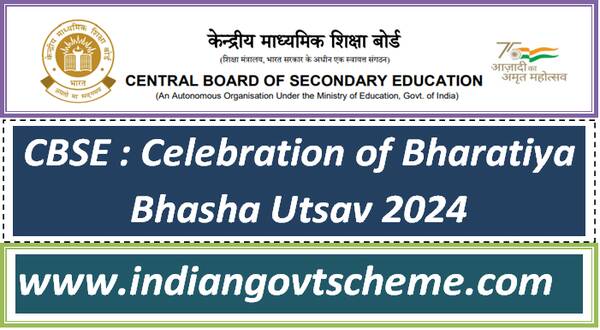CBSE/ACAD/JS(AHA)/2025
Date: 22.05.2025
Circular No: Acad-30/2025
All the Heads of Schools Affiliated to CBSE
Subject: Implementation Guidelines for Language Instruction under National Curriculum Framework for School Education-2023 for Foundational and Preparatory Stages
The National Curriculum Framework for School Education (NCF-2023), developed to realise the main goals of the National Education Policy (NEP) 2020, places renewed emphasis on the use of the home language or mother tongue as the medium of instruction in early education and the structured introduction of additional languages through a multilingual approach. In light of these directives, all schools are required to adopt and implement the language education provisions of the NCF-2023 from the current academic session (i.e. 2025-26).
1. R1, R2
The National Curriculum Framework (NCF) emphasizes that the first language of literacy (R1) in schools should ideally be the student’s mother tongue or a familiar regional/state language, as it leverages their existing linguistic, cultural, and cognitive resources, enhancing engagement and literacy effectiveness. If there are practical considerations, such as classroom diversity, resource limitations, or oral traditions lacking written forms, R1 may shift to the State Language, which would be a familiar Language. R1 must serve as the medium of instruction until foundational literacy in another language is achieved. For details regarding R1 and R2 please refer to page 239 Part C of NCFSE 23.

2. Foundational Stage (Pre-primary to Grade 2; Ages 3–8) (Languages to be taught R1 and R2)
a. Medium of Instruction At the Foundational Stage, children begin formal education in a linguistic environment that must feel natural, nurturing, and culturally rooted. As per NCFSE-2023, the primary language of learning and the medium of instruction (MoI) must be the child’s home language, mother tongue, or a familiar regional language (referred to as R1).
As per NCFSE 23(page 239) Part C, “R1 should preferably be the Language most familiar to the students, which would be the mother tongue. If that is not possible because of practical considerations, then it should be the State Language, which would be a familiar Language. Also, since it is in R1 that literacy is first attained, it must be used as the medium of instruction (MoI) for other subjects, at least until literacy in another language is attained.”
Further, in the Foundational Stage, developing Foundational Literacy and Numeracy finds adequate emphasis. The focus is on building familiarity of students with two spoken Languages (R1 and R2). At the end of this Stage, students are expected to read fluently in R1 and comprehend what they read, and begin writing sentences in R1 to express experiences, themes, and what they see in pictures, thus achieving Foundational Literacy in R1. This is crucial for ensuring meaningful engagement and cognitive development in the early years and all schools are required to implement it.
b. Learning Outcomes
The learning outcomes expected at this stage are predominantly oral and experiential. Children should develop listening comprehension, oral fluency, vocabulary, phonemic awareness, and an emergent understanding of symbols and print. Formal reading and writing are introduced, beginning with recognition of letters and basic word formation in R1.
c. Pedagogy and Learning Resources
For Balvatika stage, for play-based and activity-oriented pedagogy, schools can use Jadui Pitara and E-Jadui Pitara, available in various Indian Languages.
For classes 1 and 2, NCERT has published textbooks which are available in printed form in Hindi, Urdu and English. The books are available in digital form in other languages as well, at https://ncert.nic.in/textbook.php . These resources may be utilized keeping in view the guidance provided by NCERT regarding the transaction of these resources in classrooms.
If required, reference may be made also to the recommendations contained in NCFSE.
3. Preparatory Stage (Grades 3–5; Ages 8–11)
a. Medium of Instruction
In the Preparatory Stage, students may continue to learn in R1, which could be the preferred medium of instruction for all subjects. Section 1.6.1(d) Page 36 of NCFSE 23 states, “Since it is in R1 that literacy is first attained, it must be used as the Medium of Instruction (MoI) for other subjects, at least until literacy in another language is attained”. Accordingly, an option may be given to study in medium other than R1 to those who are interested in studying through R2 depending on whether foundational literacy in R2 has been attained.
Option of Medium of Instruction
NCFSE in section 1.6.1. recommends that at least one language native to India will be offered as an option for the medium of instruction to all students up to Grade 12. Schools are, accordingly, required to provide this option in all classes starting with the Preparatory Stage, if the primary MoI is not such language as is native to India.
b. Competencies: R1-
At the Preparatory Stage, learners are expected to develop oral language skills using complex sentence structures to communicate ideas clearly and meaningfully in various contexts. They engage in fluent conversations, summarize key ideas from oral texts, and participate in oral presentations such as storytelling, anchoring, and short speeches. Reading comprehension skills are strengthened as students learn to apply strategies like predicting, inferring, and visualizing to understand prose and poetry, extract main ideas, and draw conclusions. Writing skills progress from forming simple and compound sentences to composing coherent paragraphs that express their understanding and creativity. Learners are encouraged to create various text types such as poems, dialogues, and posters, using appropriate grammar and structure. Vocabulary development is fostered through discussion and exposure to diverse texts, enhancing their expressive and receptive language abilities. Additionally, students are guided to develop reading habits and preferences by regularly borrowing books from the library and engaging with them at home, thereby nurturing a lifelong interest in reading. (Page Number 241 NCF-2023)
R2
At the Preparatory Stage, learners are expected to build strong communication skills that support effective day-to-day interactions and oral expression. They listen attentively to stories, poems, and conversations, identify key ideas, comprehend narratives, and engage in meaningful conversations and group discussions. Their oral language abilities are further enhanced through structured opportunities for presentations and collaborative dialogue. Reading fluency and comprehension develop simultaneously, as students strengthen phonological awareness by blending and segmenting sounds, recognize text structures, punctuation, and sentence patterns, and read various texts accurately and expressively. They also begin to derive meaning from what they read—stories, poems, and story posters—and demonstrate an active interest in independently exploring children’s literature. In writing, learners begin to express their thoughts, feelings, and experiences through short paragraphs, simple posters, invitations, and instructional texts. They also explore creative writing by composing stories, poems, and dialogues. Vocabulary enrichment is integrated across all these domains, as children engage with a range of texts across subjects, discussing and understanding new words in meaningful contexts to expand their expressive capabilities. (Page Number 244 NCF-2023).
c. Pedagogy
Pedagogically, schools should adopt multilingual classroom strategies. Teachers may use translation, comparison of vocabulary and expressions across R1 and R2, and simple language games to promote engagement. Exposure to rich literary resources in both languages should be encouraged.
d. Learning Resources
Schools should refer to NCERT books, which are also available at https://ncert.nic.in/textbook.php
4. Relaxation to Children with Special Needs
Clause 17(i) in ‘Chapter III – Education’ of The Rights of Persons with Disabilities Act, 2016, stipulates that appropriate authority shall make suitable modifications in the curriculum and examination system to meet the needs of students with disabilities such as extra time for completion of examination papers, facility of scribe or amanuensis, exemption from second and third language courses.
5. Implementation Timeline and Action Plan
- To ensure uniform and effective implementation, all schools must constitute a NCF Implementation Committee by the end of May 2025. This committee will be responsible for mapping student mother tongue, aligning language resources, and guiding curriculum adjustments. The mapping of learners’ linguistic backgrounds must be completed at the earliest.
- By the end of summer break, schools should achieve realignment of the curriculum and teaching materials to reflect the use of R1 as MoI , and to ensure structured introduction of R2 at appropriate stage. Teacher orientation and training workshops should be also be completed before the implementation begins, focusing on multilingual pedagogy, classroom strategies, and language-sensitive assessment.
- Implementation may commence from July 2025. Schools requiring time to transition (for procurement of resources, teacher reallocation, or curriculum realignment) may avail of some additional time. However, care may be taken that the implementation is not inordinately delayed.
- Monthly progress reports must be submitted at the link https://forms.gle/1eL7szFn33RugVPA8 by the 5th of each month starting July 2025. Schools may also be visited by academic observers for support and guidance.
The multilingual vision of NCF-2023 is grounded in equity, inclusion, and cognitive empowerment. A child learns best in a language they understand and feel secure in. As schools, we must preserve this linguistic dignity while ensuring every learner has access to additional languages in a phased and meaningful manner. This is not just a curricular shift—it is a pedagogical commitment to India’s linguistic and cultural diversity and unity.
(Dr. Praggya M. Singh)
Director (Academics)
Copy to the respective Heads of Directorates, Organizations and Institutions as indicated below with a request to disseminate the information to all the schools undertheir jurisdiction:
1. The Commissioner, Kendriya Vidyalaya Sangathan, 18 Institutional Area, Shaheed Jeet Singh Marg, New Delhi-16
2. The Commissioner, Navodaya Vidyalaya Samiti, B-15, Sector-62, Institutional Area, Noida.
3. The Secretary, Eklavya Model Residential Schools (EMRS), MoTA, Government of India.
4. The Secretary, Sainik Schools Society, Room No. 101, D-1 Wing, Sena Bhawan, New Delhi- 110001.
5. The Chairman, Odisha Adarsha Vidyalaya Sangathan, N-1/9, Near Doordarshan Kendra, PO Sainik School Nayapalli, Bhubaneswar, Odhisha-751005.
6. The Director of Education, Directorate of Education, Govt. of NCT of Delhi, Old Secretariat, Delhi- 110 054.
7. The Director of Public Instructions (Schools), UT Secretariat, Sector 9,Chandigarh-160017
8. The Director of Education, Govt. of Sikkim, Gangtok, Sikkim –737101
9. The Director of School Education, Govt. of Arunachal Pradesh, Itanagar –791 111
10. The Director of Education, Govt. of A&N Islands, Port Blair – 744101
11. The Director of Education, S.I.E., CBSE Cell, VIP Road, Junglee Ghat, P.O. 744103,A&N Island
12. The Additional Director General of Army Education, A –Wing, Sena Bhawan, DHQ, PO, New Delhi- 110001
13. The Secretary AWES, Integrated Headquarters of MoD (Army), FDRC Building No. 202,Shankar Vihar (Near APS), Delhi Cantt-110010
14. All Regional Directors/Regional Officers of CBSE with the request to send this circular to all the Heads of the affiliated schools of the Board in their respective regions
15. The Director of School Education, Ladakh, Room No. 101, 102 Ground Floor, Council Secretariat, Kurbathang, Kargil-Ladakh
16. The Director of School Education, Andhra Pradesh, 3rd Floor, B block, Anjaneya Towers, VTPS Rd, Bhimaraju Gutta, Ibrahimpatnam, Andhra Pradesh PIN: 521456.
17. All Joint Secretary/ Deputy Secretary/ Assistant Secretary/SPS / Analyst, CBSE
18. All Head(s)/ In-Charge(s), Centre of Excellence, CBSE
19. In charge IT Unit with the request to put this Circular on the CBSE Academic Website
20. In-Charge, Library
21. The Head (Media & Public Relations), CBSE
22. DS to Chairperson, CBSE
23. SPS/PS to all directors Secretary, CBSE
24. PPS to Director (Professional Examinations), CBSE
25. Record File
Director (Academics)
Source: Click here to view/download PDF

